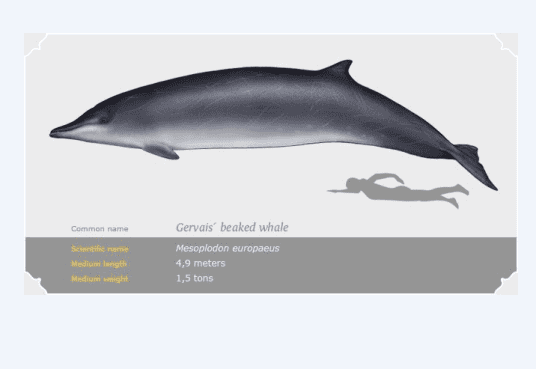Mesoplodon europaeus
IUCN
LCBasic Information
Scientific classification
- name:Mesoplodon europaeus
- Scientific Name:Theodore's beaked whale, Gulfstream beaked whale, European beaked whale, Andreas' beaked whale
- Outline:Cetacea
- Family:D.whale
Vital signs
- length:4.5-5.2m
- Weight:1-2 tons
- lifetime:No verification information
Feature
The beak is prominent and narrow, with white patches on the abdomen
Distribution and Habitat
Data are primarily from the western North Atlantic. It is the most commonly stranded species of beaked whale along the Atlantic coast of the United States. The southwestern North Atlantic appears to be the center of its range, as the United States states of Florida and North Carolina have the most records. Records have been made in the Bahamas, Jamaica, Trinidad and Tobago, and Cuba, but it is not particularly common in the Gulf of Mexico. Widely scattered strandings have been recorded in the Canary Islands, Guinea-Bissau and Mauritania in West Africa, and the Ascension Islands in the South Atlantic. This may be related to the warm waters of the Gulf Stream that crosses the Atlantic.
Appearance
The forehead is slightly protruding, the head is relatively small in proportion, the blowhole is slightly concave, the back is dark gray or sea blue, the body is spindle-shaped, the small dorsal fin is like a shark, the teeth are exposed when the mouth is closed, the beak is prominent but very narrow, the pectoral fins are darker than the abdomen, and the ends are slightly pointed. The small pectoral fins are located lower on the sides of the body. The abdomen is light gray (white for young whales), and there are irregular white patches on the abdomen, which are particularly obvious around the reproductive area. There are scars on the body, and the tail shaft is dark gray or sea blue.
The end of the dorsal fin may be blunt, the wide caudal fin is dark gray, without indentations, and the rear edge is slightly concave inward. The jaw teeth of males are 7-10 cm from the front of the jaw.
Details
Gervais's beaked whale was first recorded in the 1840s as a specimen floating in the English Channel (hence its name Mesopolodon europaeus), but no new discoveries have been made in northern Europe since then. Behavior in the wild remains speculative. The lack of sightings even in the most extensively surveyed distribution range may be related to its inconspicuous appearance. It may dive deeply and live in small groups or pairs. Some records indicate that when Gervais's beaked whales rise to breathe, their beaks usually break the water first. Scars indicate that stomatitis occurs between male whales. There have been records of them getting caught in fishing nets.

Protect wild animals and eliminate game.
Maintaining ecological balance is everyone's responsibility!








